Abstract
Electroneurographic (ENeG) and evoked potential (EP) studies were regularly performed on 11 printing workers with n-hexane polyneuropathy after cessation of exposure. At the initial examination, the ENeG studies simulated a demyelinative process. Further slowing of nerve conduction velocity, or further decreasing of action potential amplitude, or both in the follow up ENeG study were found in about half the patients. The motor distal latency did not worsen. Nerve conduction returned to normal earlier in the sensory than in the motor nerves. After the patients had regained full motor capability, conduction velocities in motor nerves were still significantly slowed. These ENeG characteristics correlate with the pathological and pathophysiological changes in experimental hexa-carbon neuropathies. The initial findings from the EP studies indicated a conduction abnormality in the central nervous system (CNS). Delayed worsening occurred in the amplitude of visual EPs in three patients. On serial follow up, the interpeak latency and interpeak amplitude of visual EPs improved little. Residual abnormalities were also found in the interpeak latency of auditory EPs in the brainstem and in the absolute latency of scalp somatosensory EPs from the peroneal nerve. Astroglial proliferation in the CNS probably impedes recovery of the abnormalities in EP.
Full text
PDF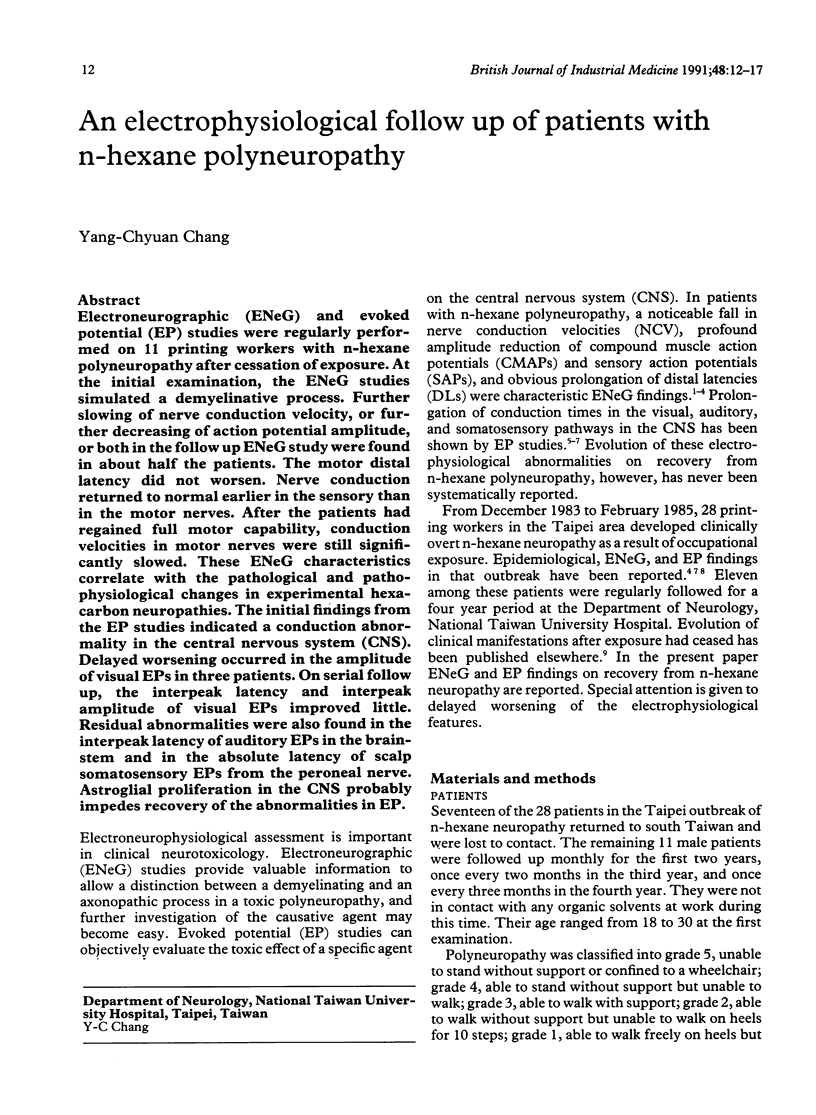
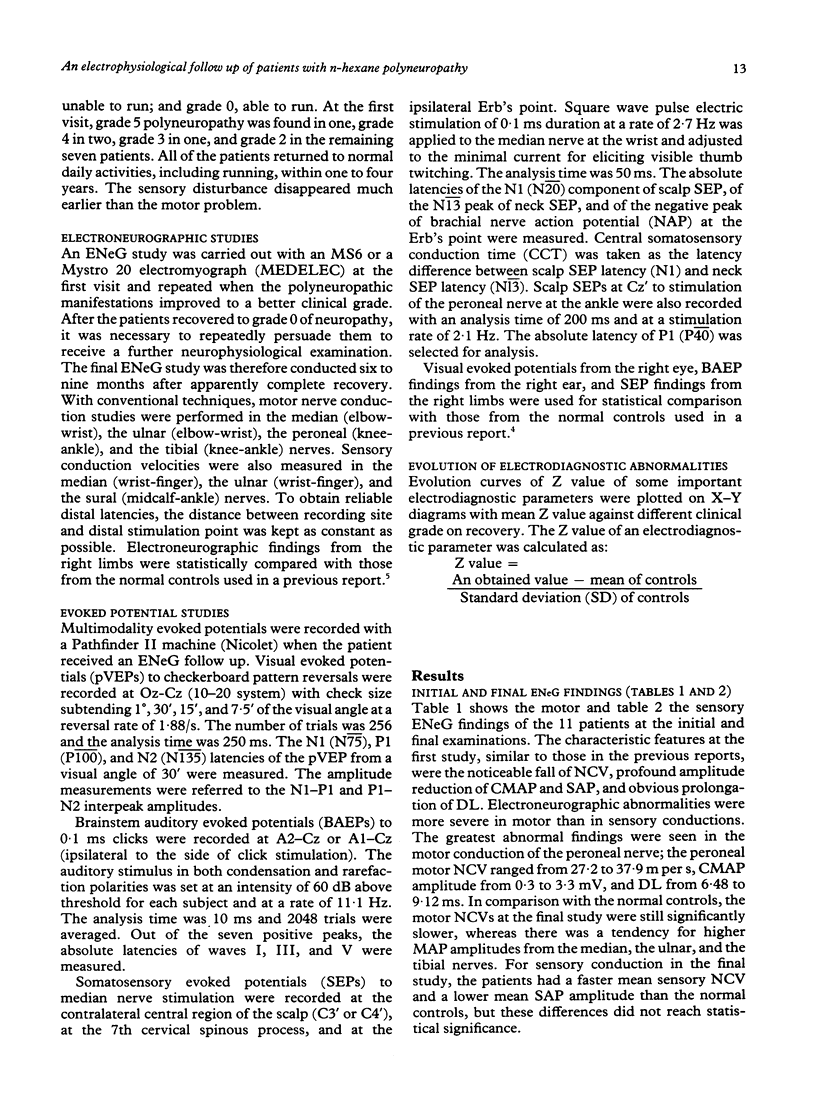
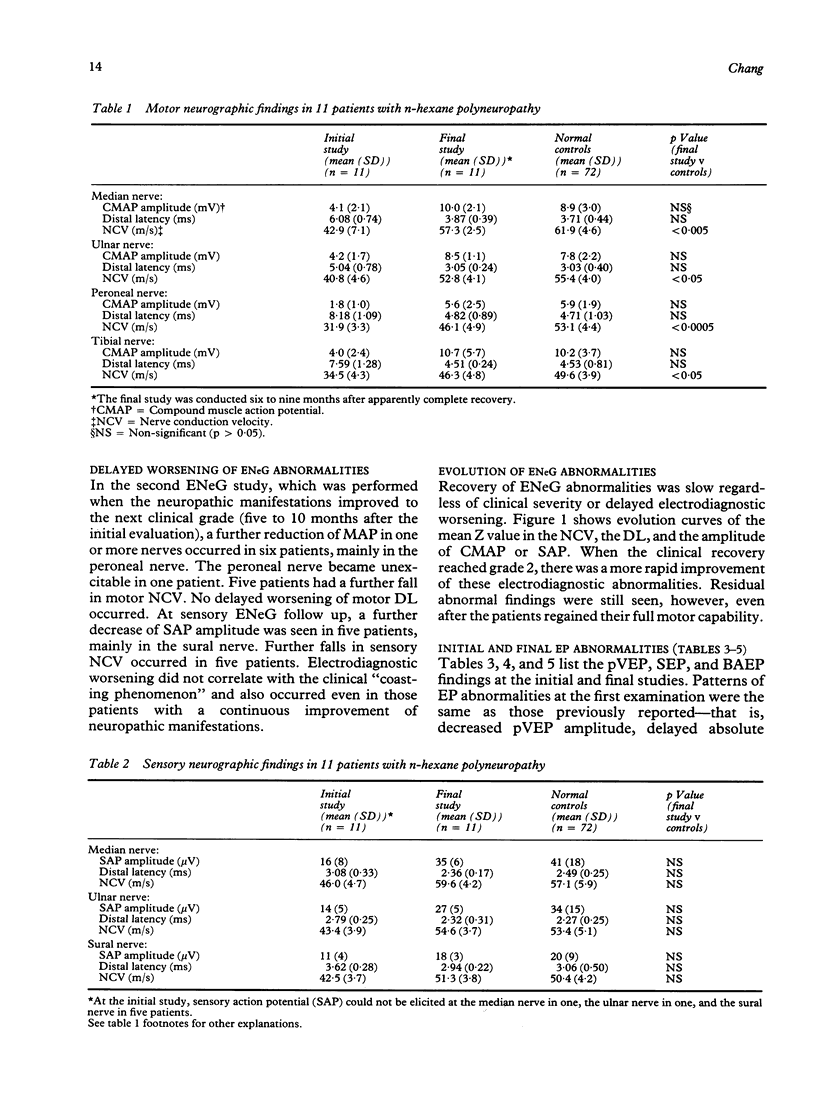
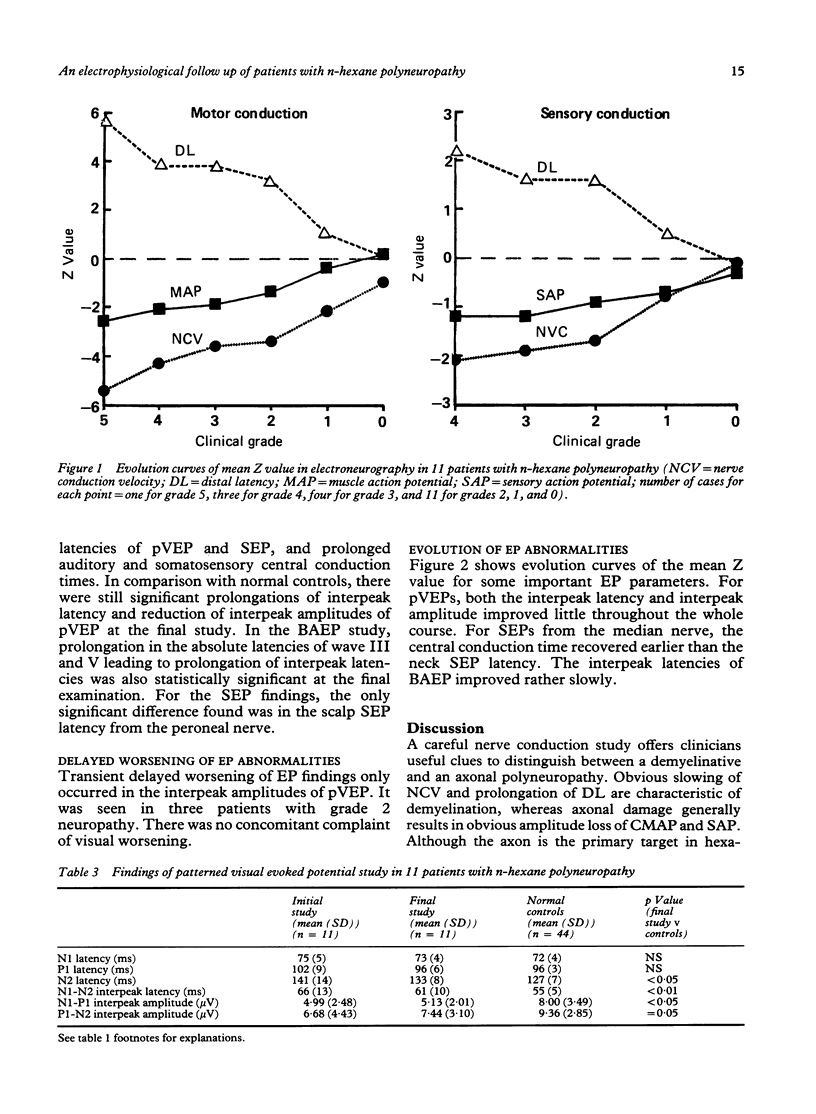
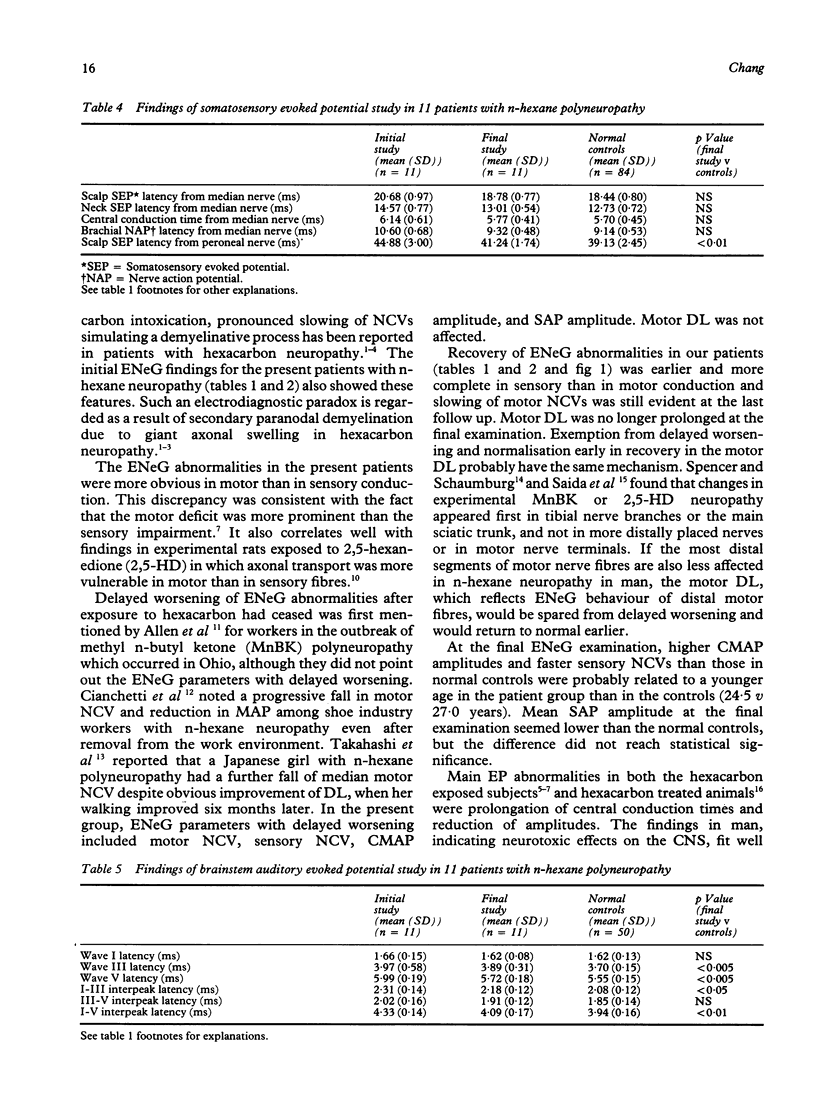
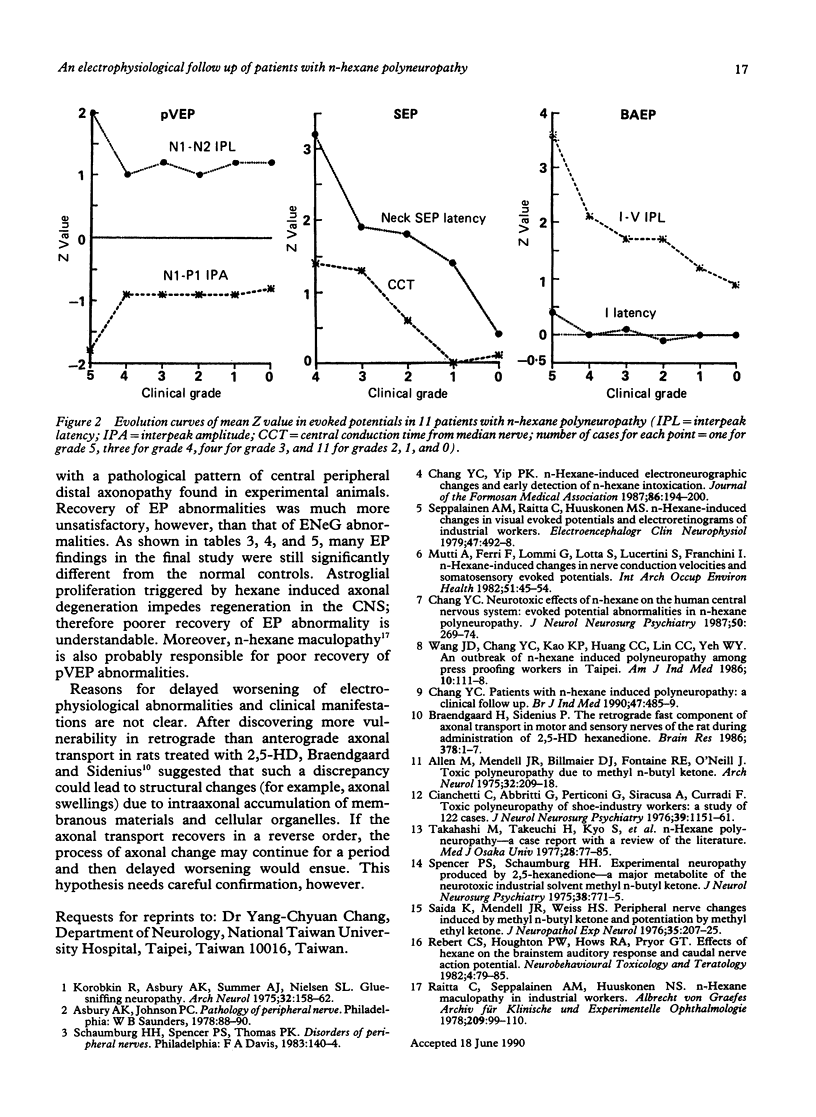
Selected References
These references are in PubMed. This may not be the complete list of references from this article.
- Allen N., Mendell J. R., Billmaier D. J., Fontaine R. E., O'Neill J. Toxic polyneuropathy due to methyl n-butyl ketone. An industrial outbreak. Arch Neurol. 1975 Apr;32(4):209–218. doi: 10.1001/archneur.1975.00490460025001. [DOI] [PubMed] [Google Scholar]
- Braendgaard H., Sidenius P. The retrograde fast component of axonal transport in motor and sensory nerves of the rat during administration of 2,5-hexanedione. Brain Res. 1986 Jul 16;378(1):1–7. doi: 10.1016/0006-8993(86)90280-5. [DOI] [PubMed] [Google Scholar]
- Chang Y. C. Neurotoxic effects of n-hexane on the human central nervous system: evoked potential abnormalities in n-hexane polyneuropathy. J Neurol Neurosurg Psychiatry. 1987 Mar;50(3):269–274. doi: 10.1136/jnnp.50.3.269. [DOI] [PMC free article] [PubMed] [Google Scholar]
- Chang Y. C. Patients with n-hexane induced polyneuropathy: a clinical follow up. Br J Ind Med. 1990 Jul;47(7):485–489. doi: 10.1136/oem.47.7.485. [DOI] [PMC free article] [PubMed] [Google Scholar]
- Chang Y. C., Yip P. K. N-hexane-induced electroneurographic changes and early detection of N-hexane intoxication. Taiwan Yi Xue Hui Za Zhi. 1987 Feb;86(2):194–200. [PubMed] [Google Scholar]
- Cianchetti C., Abbritti G., Perticoni G., Siracusa A., Curradi F. Toxic polyneuropathy of shoe-industry workers. A study of 122 cases. J Neurol Neurosurg Psychiatry. 1976 Dec;39(12):1151–1161. doi: 10.1136/jnnp.39.12.1151. [DOI] [PMC free article] [PubMed] [Google Scholar]
- Korobkin R., Asbury A. K., Sumner A. J., Nielsen S. L. Glue-sniffing neuropathy. Arch Neurol. 1975 Mar;32(3):158–162. doi: 10.1001/archneur.1975.00490450038004. [DOI] [PubMed] [Google Scholar]
- Mutti A., Ferri F., Lommi G., Lotta S., Lucertini S., Franchini I. n-Hexane-induced changes in nerve conduction velocities and somatosensory evoked potentials. Int Arch Occup Environ Health. 1982;51(1):45–54. doi: 10.1007/BF00378409. [DOI] [PubMed] [Google Scholar]
- Rebert C. S., Houghton P. W., Howd R. A., Pryor G. T. Effects of hexane on the brainstem auditory response and caudal nerve action potential. Neurobehav Toxicol Teratol. 1982 Jan-Feb;4(1):79–85. [PubMed] [Google Scholar]
- Saida K., Mendell J. R., Weiss H. S. Peripheral nerve changes induced by methyl n-butyl ketone and potentiation by methyl ethyl ketone. J Neuropathol Exp Neurol. 1976 May;35(3):207–225. doi: 10.1097/00005072-197605000-00001. [DOI] [PubMed] [Google Scholar]
- Seppäläinen A. M., Raitta C., Huuskonen M. S. n-Hexane-induced changes in visual evoked potentials and electroretinograms of industrial workers. Electroencephalogr Clin Neurophysiol. 1979 Oct;47(4):492–498. doi: 10.1016/0013-4694(79)90165-2. [DOI] [PubMed] [Google Scholar]
- Spencer P. S., Schaumburg H. H. Experimental neuropathy produced by 2,5-hexanedione--a major metabolite of the neurotoxic industrial solvent methyl n-butyl ketone. J Neurol Neurosurg Psychiatry. 1975 Aug;38(8):771–775. doi: 10.1136/jnnp.38.8.771. [DOI] [PMC free article] [PubMed] [Google Scholar]
- Takahashi M., Takeuchi H., Kyo S., Yorifuji S., Sanagi S., Seki Y., Hara I. N-hexane polyneuropathy--a case report with a review of the literature. Med J Osaka Univ. 1977 Sep;28(1):77–85. [PubMed] [Google Scholar]
- Wang J. D., Chang Y. C., Kao K. P., Huang C. C., Lin C. C., Yeh W. Y. An outbreak of N-hexane induced polyneuropathy among press proofing workers in Taipei. Am J Ind Med. 1986;10(2):111–118. doi: 10.1002/ajim.4700100202. [DOI] [PubMed] [Google Scholar]


